Sales Funnel
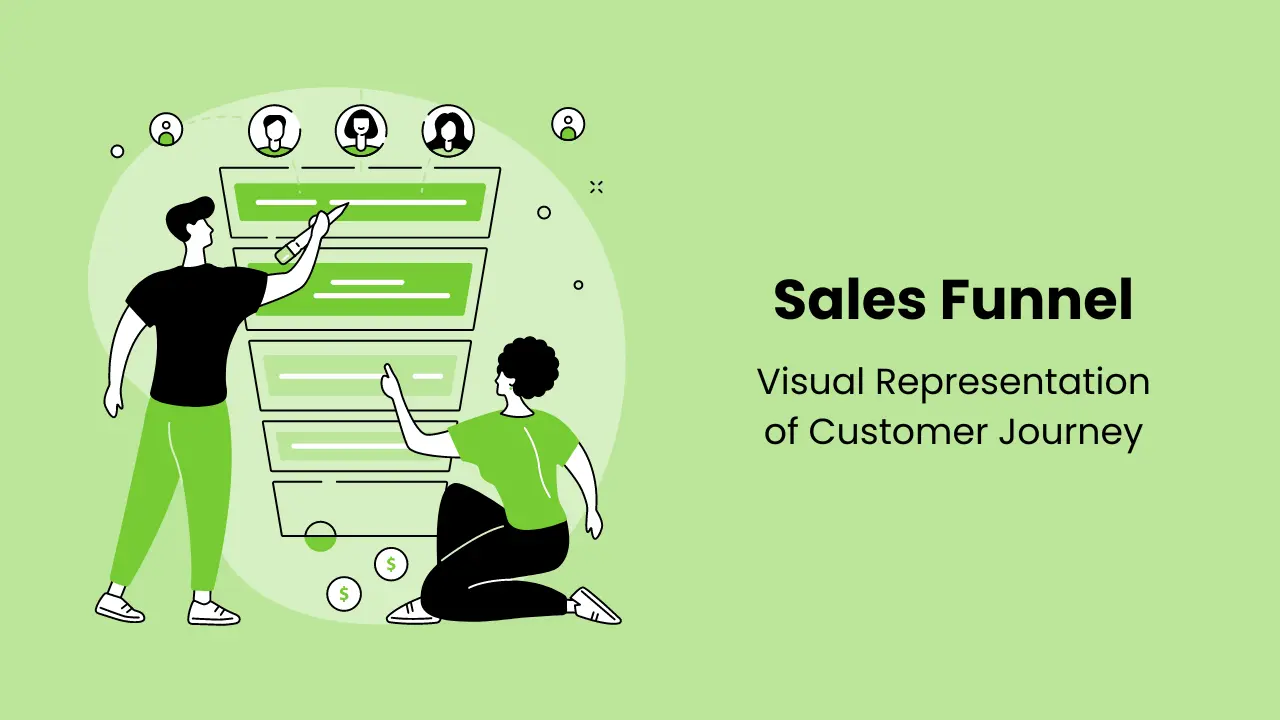
What is Sales Funnel
Sales Funnel is a visual representation of the journey your potential customers (prospects) take, from simply being aware of your brand to ultimately becoming a paying customer.
Understanding Sales Funnel
It’s a powerful tool for visualizing the customer journey, from initial awareness to final purchase. Understanding the funnel enables businesses to optimize their marketing and sales efforts, resulting in more conversions and satisfied customers.
To understand this, consider a waterfall. People at the top have yet to see your business. As they descend the falls, they learn more about you. By the end, some of them become satisfied customers who return to your business!
The sales funnel resembles that waterfall. It demonstrates how people go from never hearing about you to becoming customers. Understanding this funnel can help businesses improve their marketing and sales, bringing in more customers and keeping them satisfied!
Types Of Sales Funnel
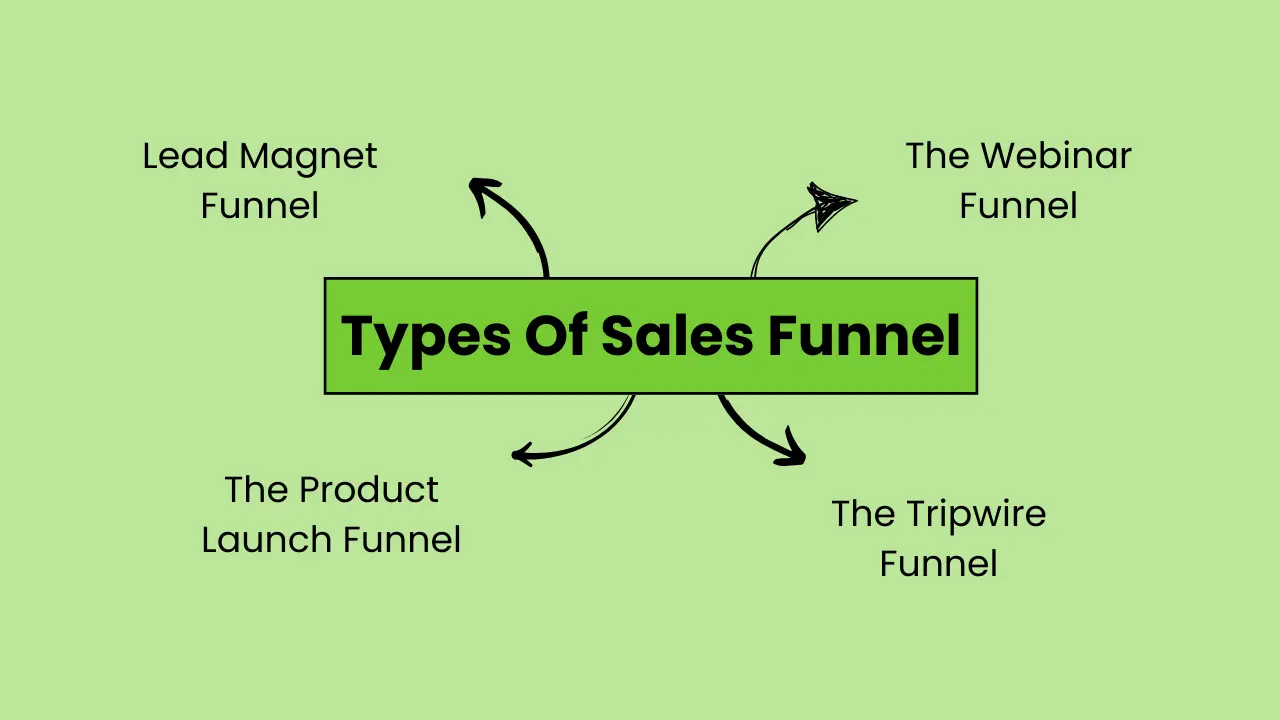
There is no one-size-fits-all approach. So let’s discuss the four main types of sales funnels, each with its own strengths. –
1. Lead Magnet Funnel:
About the funnel: This funnel focuses on attracting potential customers by providing a free offer in exchange for their contact information (typically an email address).
Features include –
- Target the top of the funnel (TOFU) – awareness stage.
- Provides valuable resources such as ebooks, guides, and webinars.
- Creates an email list to nurture leads further down the funnel.
Assume you sell fitness programs. You could offer a free “7-Day Beginner’s Workout Guide” in exchange for an email address. This enables you to nurture leads with additional fitness tips before eventually promoting your paid workout programs.
2. The Webinar Funnel:
About the funnel: This funnel focuses on hosting informative webinars to educate potential customers and demonstrate your expertise.
Features:
- Targets the MOFU (consideration stage) – nurturing leads.
- Provides useful content to increase trust and establish thought leadership.
- Captures registrations with email addresses for future communication.
For example, an accounting software company might host a webinar titled “Top Tax Tips for Small Businesses.” Attendees would need to register with their email address so that the company could follow up with free software trials or demos.
3. The Product Launch Funnel:
About the funnel: This funnel generates excitement and anticipation for a new product launch.
Features:
- Creates a sense of urgency and exclusivity for upcoming products.
- Uses email marketing, social media campaigns, and limited-time offers.
- Captures pre-orders or early access registrations to build initial sales momentum.
For example, a clothing brand may use social media teasers and email campaigns to announce a limited-edition clothing line. This heightens anticipation, encouraging customers to pre-order the new collection before it sells out.
4. The Tripwire Funnel:
The funnel features a low-cost introductory product to entice potential customers.
Features include –
- Targeting the BOFU (decision stage) and conversion stage.
- Offers a low-risk way for customers to experience the value proposition.
- The goal is to convert them into paying customers for higher-priced products later.
For example, a company that sells productivity software may offer a discounted introductory month on their basic plan. Once the customer has experienced the value, they may be more likely to upgrade to a premium plan with additional features.
Sales Funnel Examples
So, now we know what a sales funnel is and what its types are, let us understand it in more detail with the help of some interesting examples.
Example 1: Fitness Tracker Company
![]()
Imagine you’re a company selling fitness trackers. Here’s how your sales funnel might look:
Top of the Funnel (TOFU): This is where you create awareness and attract potential customers who might be interested in getting fit or improving their health. You might:
- Run social media ads showcasing people using your fitness tracker and achieving their fitness goals.
- Create blog posts on topics like “Top 10 Fitness Tips for Beginners” or “How to Track Your Sleep for Better Health.”
- Partner with fitness influencers to promote your tracker on their channels.
Middle of the Funnel (MOFU): Here, you nurture leads who are now aware of your fitness tracker and might be considering buying one. You might:
- Offer a free downloadable guide on “Creating a Personalized Fitness Plan.” This requires an email signup, allowing you to capture leads.
- Host a free webinar on “Maximizing Your Workouts with Fitness Trackers.” Attendees would register with their email, providing valuable contact information.
- Send targeted email campaigns with educational content on using fitness trackers and success stories from satisfied customers.
Bottom of the Funnel (BOFU): This is where you convert leads into paying customers. You might:
- Offer a discount on your fitness tracker for a limited time.
- Highlight customer testimonials on your website showcasing the positive impact of your product.
- Run retargeting ads on social media to remind website visitors who viewed your products but didn’t purchase yet.
Example 2: Online Language Learning Platform
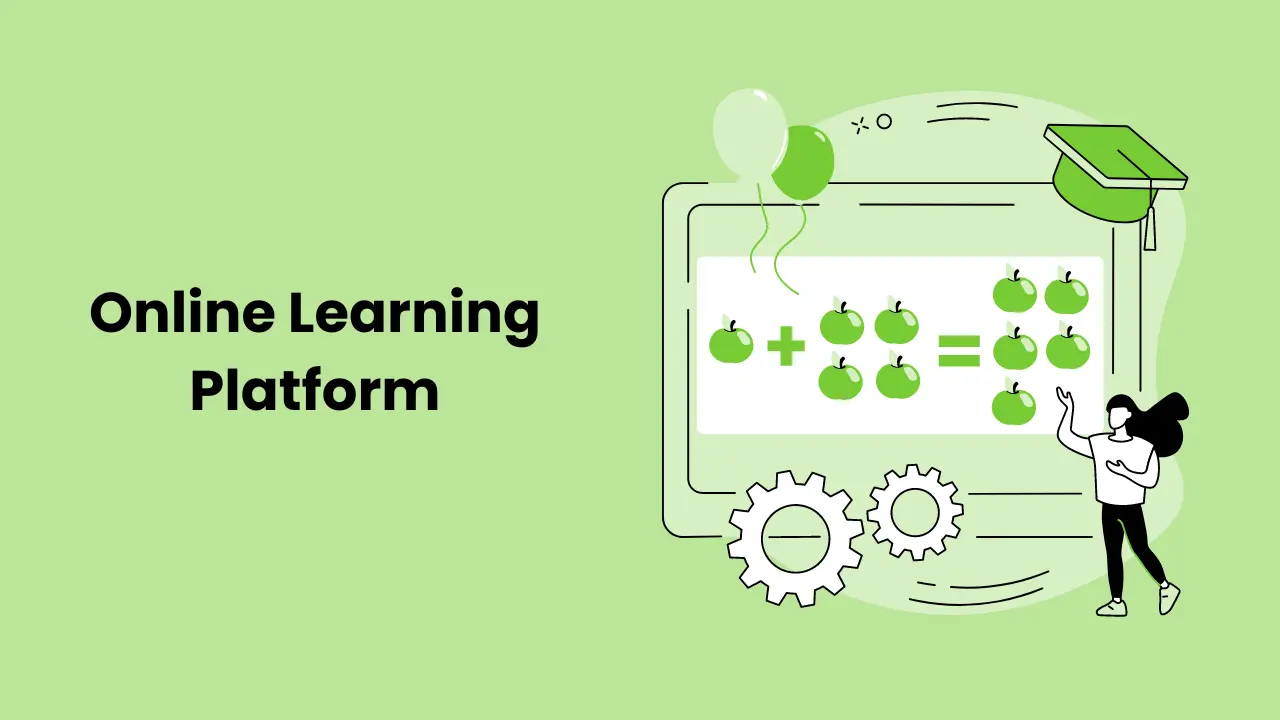
Let’s say you run an online platform for learning a new language. Here’s a possible structure for your funnel:
TOFU: Attract people interested in learning a language but unsure where to start. You might:
- Develop a free online language quiz to assess someone’s current language level.
- Create informative YouTube videos on language learning tips and cultural insights.
- Run social media campaigns with engaging content showcasing the benefits of learning a new language.
MOFU: Nurture leads who are actively considering learning and might be evaluating different platforms. You might:
- Offer a free trial of your online language learning platform, allowing users to experience some features before committing.
- Host live Q&A sessions with language experts to address common questions and showcase your platform’s value.
- Send personalized email sequences based on user interests, offering relevant language learning resources and success stories.
BOFU: Convert leads into paying subscribers. You might:
- Highlight different subscription plans catering to various learning needs and budgets.
- Offer bonus materials like downloadable vocabulary lists or interactive exercises for paid subscribers.
- Provide time-limited promotions on annual subscriptions or bundled learning packages.
Tools For Sales Funnel
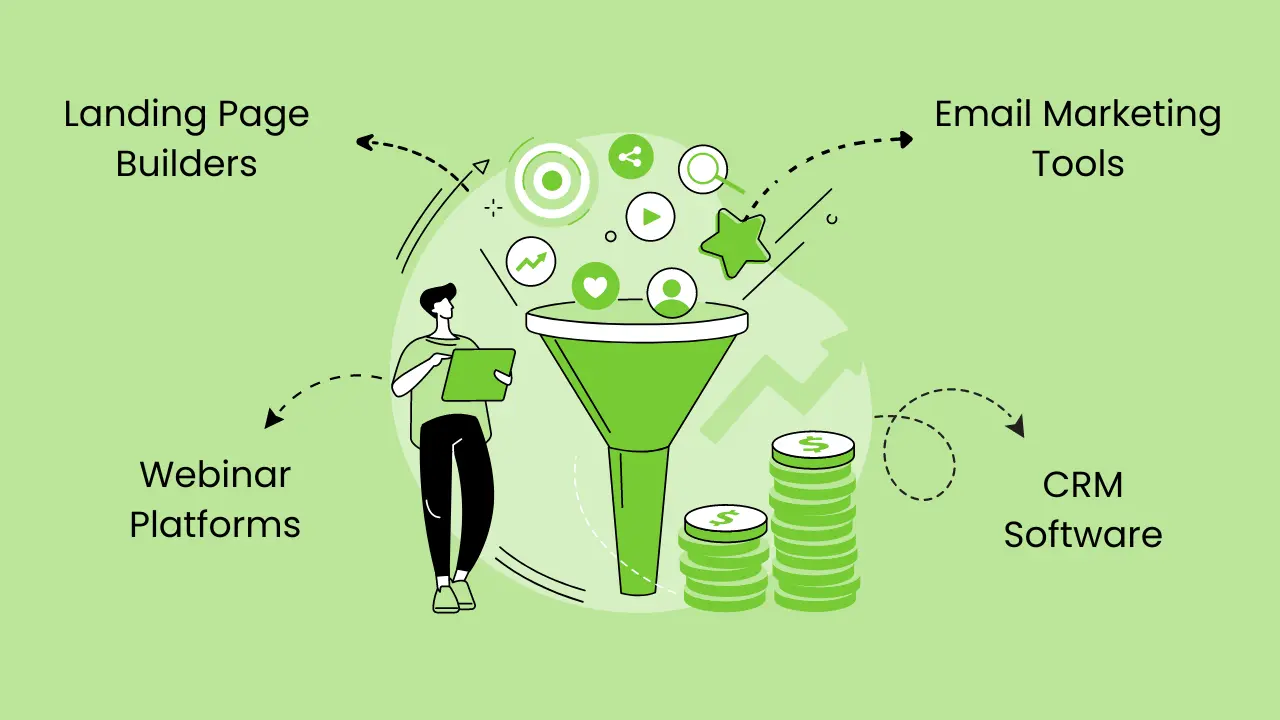
Building effective sales funnels requires the right tools. Here are some useful options that businesses or marketers could prefer:
1. Landing Page Builders (TOFU & MOFU):
Landing page builders allow you to create high-converting landing pages specifically designed to capture leads or promote specific offers.
Features: Drag-and-drop interface, pre-built templates, analytics integration, lead capture forms, A/B testing capabilities.
How it helps: Businesses and marketers can easily create targeted landing pages for each stage of the funnel, maximizing conversions and lead generation.
Popular options include:
- Leadpages: User-friendly platform with strong lead capture features (Free trial, Paid plans start at $25/month).
- Unbounce: Conversion-focused builder with A/B testing and pop-up creation (Free trial, Paid plans start at $80/month).
- ClickFunnels: All-in-one solution with landing page builder, email marketing, and sales pipeline management (Free trial, Paid plans start at $97/month).
2. Email Marketing Tools (MOFU & BOFU):
Email marketing tools help you manage email lists, create and send targeted email campaigns, and track campaign performance.
Features: Email automation workflows, segmentation capabilities, email template library, analytics and reporting dashboards.
How it helps: Businesses and marketers can nurture leads with relevant email sequences, promote offers, and convert leads into paying customers.
Popular options include:
- Mailchimp: Great for beginners with a free plan for limited contacts (Free plan, Paid plans start at $11/month).
- Constant Contact: Reliable platform with strong automation features and deliverability rates (Free trial, Paid plans start at $20/month).
- ActiveCampaign: Advanced automation capabilities for complex nurture sequences and segmentation (Free trial, Paid plans start at $15/month).
3. Webinar Platforms (MOFU):
Webinar platforms facilitate hosting live online presentations and engaging with your audience.
Features: Screen sharing, video conferencing, audience engagement tools like polls and Q&A, registration management.
How it helps: Businesses and marketers can host informative webinars to educate potential customers, showcase expertise, and generate leads through registrations.
Popular options include:
- GoToWebinar: Established platform with a robust feature set for large webinars (Free trial, Paid plans start at $89/month).
- Zoom Webinars: User-friendly and scalable solution for webinars of all sizes (Free plan for up to 100 participants, Paid plans start at $14/month per host).
- WebinarJam: Interactive platform with built-in marketing automation features (Free trial, Paid plans start at $47/month).
4. CRM Software (BOFU):
CRM (Customer Relationship Management) software helps manage customer interactions, track leads, and streamline sales processes.
Features: Contact management, deal pipeline tracking, sales task automation, reporting and analytics.
How it helps: Businesses and marketers can manage leads and customer relationships more effectively, improve sales team performance, and close more deals.
Popular options include:
- HubSpot CRM: Free plan with basic features, paid plans offer advanced sales automation tools (Free plan, Paid plans start at $45/month).
- Salesforce Essentials: Feature-rich CRM platform for managing leads, opportunities, and customer data (Free trial, Paid plans start at $25/month per user).
- Zoho CRM: Affordable CRM solution with a wide range of features and integrations (Free plan for up to 3 users, Paid plans start at $12/month per user).
Techniques For Sales Funnel
Sales funnel techniques are specific strategies you can implement within each stage of the sales funnel (TOFU – Top of Funnel, MOFU – Middle of Funnel, BOFU – Bottom of Funnel) to improve lead generation, nurture prospects, and ultimately convert them into paying customers.
How Do They Work?
By employing a variety of techniques within each funnel stage, you can create a seamless and engaging customer journey. These techniques address the specific needs and motivations of potential customers at each stage, moving them steadily towards a purchase decision.
Example Techniques for Each Stage:
- TOFU (Awareness & Education):
- Content Marketing: Create informative blog posts, articles, or infographics that address common pain points and establish your brand as a thought leader.
- Social Media Marketing: Run targeted social media campaigns to raise brand awareness and engage potential customers with relevant content.
- Search Engine Optimization (SEO): Optimize your website content with relevant keywords to improve organic search ranking and attract qualified leads.
Imagine: You sell fitness trackers. A TOFU technique could be creating a blog post on “5 Simple Habits to Develop a Healthy Lifestyle.” This attracts potential customers interested in fitness and positions your brand as a source of valuable information.
2. MOFU (Consideration & Nurturing):
- Lead Magnets: Offer free downloadable resources like ebooks, whitepapers, or webinars in exchange for email addresses.
- Email Marketing: Develop targeted email sequences that provide valuable content, address specific needs, and nurture leads towards a buying decision.
- Retargeting Ads: Show targeted ads to website visitors who haven’t converted yet, reminding them about your products or services.
Example: In the MOFU stage, you might offer a free downloadable guide on “Choosing the Right Fitness Tracker for Your Needs.” This educates potential customers, builds trust, and captures their email addresses for further nurturing.
3. BOFU (Decision & Conversion):
- Compelling CTAs (Call to Action): Use clear and persuasive CTAs on your website and landing pages to encourage conversions (e.g., “Buy Now,” “Start Your Free Trial”).
- Limited-Time Offers: Create a sense of urgency with limited-time discounts, promotions, or early-bird access to incentivize immediate purchase.
- Customer Testimonials & Social Proof: Showcase positive customer reviews, testimonials, and case studies to build trust and address potential buying hesitations.
In the BOFU stage for your fitness tracker: You could offer a discount code for a limited time, highlight customer testimonials about how your tracker helped them achieve their fitness goals, and showcase a strong call-to-action button like “Buy Now and Get Started on Your Fitness Journey Today!”
If you implement these techniques strategically within your sales funnel, you can guide potential customers on a smooth journey from initial awareness to loyal brand advocacy. Experiment, track results, and refine your approach to create a sales funnel that effectively converts leads into paying customers.
Dollar Shave Club: A Winning Example of the Sales Funnel in Action
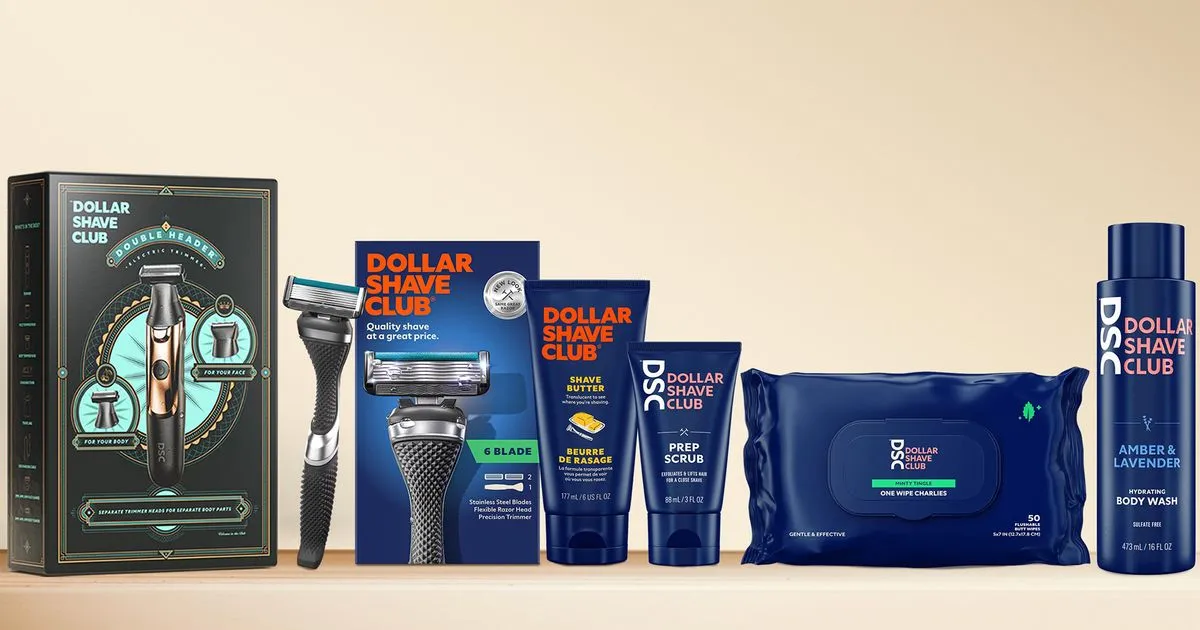
Source: Unilever
Dollar Shave Club (DSC) is a prime example of a brand that skyrocketed to success thanks to a well-defined and optimized sales funnel. Here’s how they leveraged the funnel concept to disrupt the traditional razor market:
TOFU (Awareness & Education):
- Viral Marketing Video: DSC launched with a now-iconic, humorous video on YouTube titled “Our Blades Are F*cking Great.” This edgy and attention-grabbing video went viral, generating massive brand awareness and challenging the perception of expensive, overhyped razors.
- Social Media Engagement: DSC actively engaged with viewers on social media platforms, capitalizing on the video’s momentum and building a community around their brand.
MOFU (Consideration & Nurturing):
- Subscription Model: DSC offered a convenient subscription model, delivering high-quality razors directly to customers’ doorsteps at a lower cost than traditional options.
- Free Trial: They incentivized first-time purchases with a low-cost trial offer, allowing customers to experience the product before committing to a full subscription.
- Informative Content: DSC provided informative content on their website and social media channels, addressing common shaving concerns and highlighting the benefits of their razors.
BOFU (Decision & Conversion):
- Simple & Secure Checkout: The checkout process was streamlined and secure, encouraging customers to complete their purchase with ease.
- Referral Program: DSC implemented a referral program, rewarding existing customers with incentives for recommending the brand to friends and family.
- Subscription Management: Customers could easily manage their subscriptions online, adjust delivery frequency, or cancel at any time, reducing purchase commitment concerns.
Benefits Achieved:
By implementing a strategic sales funnel, Dollar Shave Club achieved remarkable results:
- Disrupted the Market: The brand challenged the dominance of established razor companies by offering a more affordable and convenient solution.
- Rapid Growth: DSC experienced explosive subscriber growth, demonstrating the effectiveness of their sales funnel approach.
- Customer Loyalty: Their subscription model fostered long-term relationships with customers, providing a steady revenue stream.
Conclusion
The sales funnel is a strategic framework that depicts the entire customer journey, from initial brand awareness to final purchase. Businesses can effectively guide potential customers to conversion by understanding the various stages (TOFU, MOFU, and BOFU) and implementing relevant tools and techniques.
We looked at different types of sales funnels, each with its own set of benefits, and how tools like landing page builders, email marketing platforms, and CRM software can help streamline the process. Furthermore, real-world examples such as Dollar Shave Club demonstrated the transformative impact that a well-defined sales funnel can have on a company’s success.
By adopting the sales funnel concept and constantly refining your approach, you can create a smooth and engaging customer journey that converts leads into loyal brand advocates.





We would love to have your opinion.